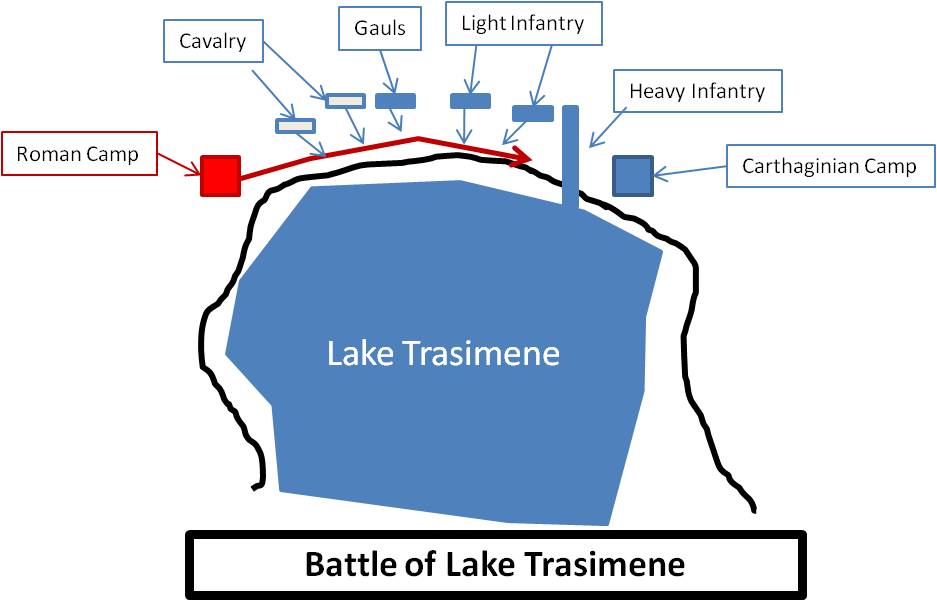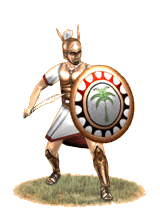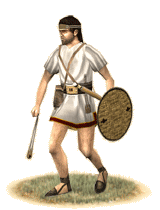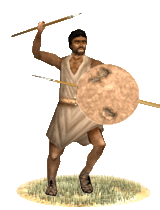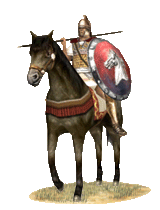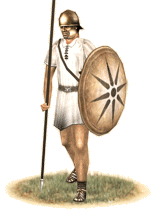The year is 217 B.C. and Hannibal
has just won a decisive victory giving him supplies and new allies from the oppressed
Gallic tribes. Two new consuls are
appointed to deal with Hannibal, Servilius Geminus and Caius Flaminius. Consul Geminus had orders to protect the
roads leading to Rome, and Consul Flaminius was ordered to protect the Apennine
passes. Both Consuls moved fast, but Hannibal
moved faster and passed Consul Flaminius, pillaging as he went and was able to
get Flaminius to give chase. Hannibal was traveling down the Malpasso road on
the north side of the Lake Trasimene, he noticed that the road narrowed here
and ended in a small valley. To the
right of the road was the lake and on the left a wooded slope that stretched alongside
it from point of entry all the way to the small valley. In his mind Hannibal thought this to be a
perfect location for an ambush, one that would be known as the largest
successful ambush in military history. With
the Romans behind a day Hannibal set to work immediately, setting camp in the
small valley at the end of the road. The
strength of the Roman legion numbered at about 40,000 thousand while Hannibal’s
army was in between 40 to 50,000 strong (Civilian Military Intelligence Group).
After making camp in the valley Hannibal started to line his troops
along the road, placing his Spanish heavy infantry combined with Hannibal’s
elite veterans to guard the camp and pin the Roman column. Hannibal then placed his cavalry and heavy
Gallic infantry further up the road hidden in the wooded slopes to stop any
Roman retreat. To finish his trap
Hannibal placed the rest of his force, the light infantry, into the bushes and
low brush along the flatter ground between the slopping woods and valley
surrounded by hills. This formation
would entrap the traveling Roman column and push them into the lake. As night fell Hannibal sent some skirmishers
further down the valley with instructions to light camp fires. This was a rouse to trick the Romans into thinking
the Carthaginians had made camp at a greater distance than they really
were. The next morning visibility was
terrible because of fog that had risen from the lake during the night. Hannibal’s officers were told the day before
to hold position and only attack when the signal was given. As the Roman column made their way down the
road, it was apparent that the expected no opposition. The only Romans in a defensive formation was
the Roman vanguard, the rest of the column was in an open format. When the vanguard finally made contact with
the veterans in camp, the whole Roman line was trapped and this is what
Hannibal, He had the horns blown and the Carthaginians fell upon the unsuspecting
Romans who were caught by surprise. Even
so, the defeat of the Romans took four hours and their commander Flaminius, was
supporting his troops wherever they were pressed hardest until a Gallic
horseman ran him through with a lance.
Losses by the Romans were high, about 15,000 soldiers were killed and it
is estimated that another 10,000 were captured and sold into slavery (livius); news of
this defeat terrified the citizens of Rome.
This led to the appointment of Quintus Fabius Maximus who was a veteran
of 58 as dictator. After this new
victory for Hannibal, there was no army to stand against him while he continued
his march south toward the heel of the Italian peninsula.
Wednesday, April 18, 2012
Sunday, April 15, 2012
Friday, April 13, 2012
Battle of Cannae
As Hannibal continued to ravage the fields and vineyards belonging to Roman citizens, the Roman Senate was pressured to take action. Their plan was to appoint Consuls Caius Terentius Varro and Lucius Aemilius Paullus, Varro wanted to face Hannibal in a up front battle and Paullus was more opposed to that idea and wanted instead to pick off Hannibal's forces because of Hannibal's known tricks. The two Consuls were given a double sized Legion and were to co-command this army. In the year 216 B.C. they set out to face Hannibal (UNRV). to give the Romans some over confidence Hannibal himself led a raiding mission whose soul purpose was to drive into the Roman column and then retreat in a false terror. This plan had the effect that Hannibal wanted,making Consul a little reckless. The Romans had in command 80,000 soldiers of both Roman citizens and allies. Hannibal had with him a mix of 50,000 soldiers with him, and he knew all of their strengths and how to play on those strengths (Encyclopedia Britannica Online). Hannibal was camping by the Cannae river when the Romans under the command of Consul Varro, came to battle. Varro wanted to battle next to the river so that he could back the Carthaginians into it and prevent escape, and the flat ground that was the battle field provided Hannibal with no where to hide troops or use to his advantage. What Hannibal did instead became a classic in western military history and gave the Romans their worst defeat in military history. The Romans with the advantage in numbers decided to line their infantry into two bulky squares, whose job was simple, crash through the Carthaginian line and defeat the infantry. The Roman cavalry were to hold off the Carthaginian cavalry while the infantry did their job. Hannibal had other plans for this. Hannibal put his Iberian and Gallic infantry in the center and his African veterans on their flanks and further back to form an arrow head. On the flanks of his infantry he placed his cavalry, Numidian light cavalry on the right and Spanish and Gallic heavy cavalry on the left, the cavalries job was the same as the Romans, hold off the opposing cavalry. Hannibal's plan was that has the cavalry attacked each other, his infantry would slowly give way to the Roman line. As the Romans went deeper into the Carthaginian line they would become in-cohesive, and his strong veteran flanks would close upon them while his cavalry would swing back and finish the circle (Encyclopedia Britannica Online). The battle went perfectly for Hannibal, and he won even with the numerical disadvantage. Rome suffered losses over 60,000 of infantry and cavalry as high as 3,000. Hannibal on the other hand only received casualties as high as 8,000 infantry and 2,000 cavalry (UNRV). This still remains as one of Hannibal's greatest achievements.
Thursday, April 12, 2012
Wednesday, April 11, 2012
Hannibal's Troops
Some of the different Troops and what the would have looked like in the time of the second punic war
Subscribe to:
Comments (Atom)
